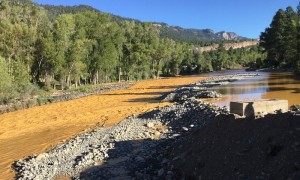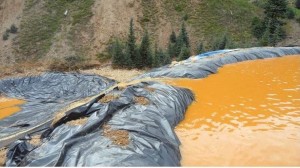
By Nick Law, Staff Writer and Editor for Save The Water™ | October 14, 2015
On August 5, 2015, 3 million tons of toxic sludge leaked into the Animas River in Colorado, giving its waters a bright yellow hue. According to most news sources, the leak was caused by a team of workers employed by the Environmental Protection Agency.1 The Gold King Mine has been leaking fluids into its surrounding area since its shuttering in 1923. This has resulted in the formation of dozens of toxic wells in its immediate vicinity. In order to contain this environmental disaster, work crews from the EPA have been attempting to “slurp out the worst pools of sludge and dispose of them properly.”2
But while they were working near Silverton, some of their heavy equipment “disturbed an earthen wall that secured the liquid, releasing an up to 80-mile ribbon of pollution downstream.”2 The contaminated water contains high levels of heavy metals, “including lead and arsenic.”1 A few days later, water tests after the spill indicated that levels of arsenic and lead were respectively at “300 and 3,500 times the normal levels.”2
EPA Promises to Do Better, But Farmers and City Near Gold King Mine Suffer
Since then, the EPA has owned up to causing the incident. Also, EPA has promised prompt rectification measures and the establishment of new oversights to better prevent a similar spill.2 That aside, the incident compromised the livelihood of many farmers situated along the Animas River and its tributaries. The incident also affected the city of Durango was also affected. That city draws a significant amount of its water supply from the Animas River. And much of its tourist trade depends on “water-based recreation.”3
Fortunately, no one died because of this spill. So far, current reports indicate that park agents and biologists working for La Plata County have found no significant amounts of dead fish or animals in or beside the polluted water bodies. This means that the polluted water poses little danger to fish or other wildlife.4 But the long term consequences of this incident remain to be seen.

Arsenic Spilled into the Animas River
Despite the well known, adverse health effects of exposure to heavy metal contaminants, worldwide people continue using heavy metals today. For example, one major pollutant is arsenic. Arsenic spilled into the Animas River. A metalloid, arsenic occurs naturally in rock, soil, water, and air. Its inorganic form is present in groundwater used for drinking in several countries all over the world. Meanwhile, its organic compound is primarily found in fish.5 It can also come into contact with humans through pesticides, wood preservatives, and contaminated food and water. Moreover, contaminated “soils such as mine-tailings… [are another] potential source of arsenic exposure.”5
Similarly, inorganic arsenic is also extremely toxic. “[I]ntake of large quantities leads to gastrointestinal symptoms, severe disturbances of the cardiovascular and central nervous systems, and eventually death. In survivors, bone marrow depression, haemolysis, hepatomegaly, melanosis, polyneuropathy and encephalotopathy may be observed.”5 Individuals exposed to arsenic through drinking water face “excess risk of mortality from lung, bladder, and kidney cancer.”5
Mines Leak Lead, Which Could Hurt Children in Particular
The other major pollutant, lead, is another common metal used frequently in many modern day products. Most notably, burning petrol produces in lead emissions. Similarly, working in mines, smelters, or battery plants may expose individuals to lead. All of these places give off high levels of lead emissions that suffuse their surrounding area. This causes airborne lead to “be deposited on soil and water, thus reaching humans via the food chain.”5 Acute lead poisoning causes headaches, irritability, abdominal pain, and various nervous system-related symptoms. In particular, lead poisoning more drastically harms children. In addition to other symptoms, children may suffer from behavioral disturbances as well as learning and concentration difficulties. Long-term exposure to lead can result in permanently diminished mental faculties in adults and stunted growth in children.5

Mines Must Manage Their Waste Water – Passive and Active Treatment
Since exposure to heavy metal contaminants can result in such harms to human health, mines must scrupulously manage their waste water. Most mining operations recognize this and develop “water management plans to minimize the potential for water contamination… and to prevent the release of polluted water into the environment.”6 Some mines use water control techniques, such as diverting surface and drainage water from the mine site, recycling water used for processing ore, using evaporation ponds for contaminated water, and installing liners and covers on waste rock and ore piles to prevent them from coming into contact with groundwater.6
Whereas other mines take their measures one step further by treating the contaminated water produced by their operations with technologies that can be categorized as either active or passive. In active water treatment, acidic mine waters are treated with alkaline compounds such lime, limestone, or caustic soda. The elevation of the pH levels causes dissolved metals to precipitate and to sink to the bottom of the sedimentation ponds that hold this water. Subsequently, people can remove these sediments. Other technologies such as ion exchangers, membrane filters, and reverse osmosis might also be used to achieve a similar effect.6
In contrast, passive water treatment relies on “natural physical, chemical, and biological processes that remove water… [contaminants] without additional physical or chemical inputs… [Some] of these processes include bacteria-controlled metal precipitation, contaminate uptake by plants, and filtration through soil and sediments.”6 Thus, these mines rely on constructed wetlands in which natural mechanisms filter and purify contaminated water. After that, the water can rejoin other water bodies. But passive water treatment requires constant, challenging water monitoring. As a result, it can be ineffective when dealing with highly acidic water.
Gold King Mine, Trying Everything But the Balance Did Not Work
Around Gold King Mine, the work crews were trying to control the contaminated water with a variety of the aforementioned methods. Mainly, they used evaporation ponds and combined active and passive water treatment processes in a bid to induce metal precipitation. Despite their efforts, a sudden accident and error in judgment on their part caused massive quantities of lead and arsenic to flow into the Animas River.
Although the effects of the spill have so far been relatively minor, no one knows the long-term consequences yet. Mining is an essential aspect of the global economy. As a consequence, calls to curtail or reduce mining operations are unreasonable and unproductive. Nonetheless, mines could definitely benefit from improved sustainable water management technologies directed at the prevention of any contamination issues. Save the WaterTM is a non-profit organization focused on the development of water science. Any contributions you can make to our research and development endeavors will help us to prevent an incident like the Animas River spill from ever occurring again.
References
- Kaylee Heck. August 10, 2015. “Three Million Gallons of Contaminated Water Turns River Orange in Colorado.” ABC News. http://abcn.ws/1gsZJSo
- Tony Dokoupil. August 10, 2015. “EPA owns up to toxic sludge leak tainting Colorado river.” MSNBC. http://www.msnbc.com/msnbc/epa-owns-toxic-sludge-leak-tainting-colorado-river
- Erinn Morgan. August 10, 2015. “Durango copes with ‘orange nastiness’ of toxic sludge river pollution.” http://bit.ly/2GuubtL
- Alex Johnson. August 11, 2015. “Colorado River Spill: Early Tests Show Little Threat to Fish, Wildlife.” NBC News. http://nbcnews.to/1gweP9P
- Lars Järup. December 1, 2003. “Hazards of heavy metal contamination.” British Medical Bulletin. http://bmb.oxfordjournals.org/content/68/1/167.long
- Miningfacts.org. “How is water managed and treated in mining?” http://www.miningfacts.org/Environment/How-is-water-managed-and-treated-in-mining/

